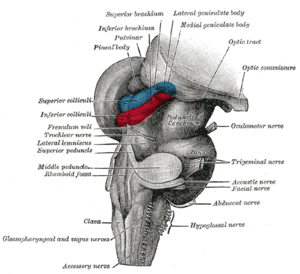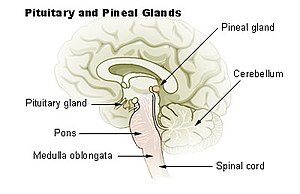Pineal gland

The pineal gland (also called the pineal body or epiphysis) is a small endocrine gland in the brain. It is located near the center of the brain, between the two hemispheres, tucked in a groove where the two rounded thalamic bodies join. A recent review of the pineal and its secreted hormone, melatonin, is available.
Location
The pineal gland is a reddish-gray body about the size of a pea (8 mm in humans) located just rostro-dorsal to the superior colliculus and behind and beneath the stria medullaris, between the laterally positioned thalamic bodies. It is part of the epithalamus.
The pineal gland is a midline structure, and is often seen in plain skull X-rays, as it is often calcified.
Structure and composition
The pineal gland consists mainly of pinealocytes, but four other cell types have been identified: interstitial cells, perivascular phagocyte, pineal neurons and peptidergic neuron-like cells.
The pineal body consists in humans of a lobular parenchyma of pinealocytes surrounded by connective tissue spaces. The glands' surface is covered by a pial capsule. The pinealocytes consist of a cell body with 4-6 processes emerging. The pinealocytes can be stained by special silver impregnation methods. Insterstitial cells are located between the pinealocytes. Many capillaries are present in the gland, and perivascular phagocytes are located close to these blood vessels. The perivascular phagocytes are antigen presenting cells. In higher vertebrates neurons are located in the pineal gland. However, these are not present in rodents. In some species, neuronal-like peptidergic cells are present. These cells might have a paracrine regulatory function. Human follicles contain a variable quantity of gritty material, called brain sand, acervuli, or corpora arenacea. Chemical analysis of acervuli show that they are composed of calcium phosphate, calcium carbonate, magnesium phosphate, and ammonium phosphate. (Bocchi & Valdre, 1993). Recently, calcite deposits have been described as well (Baconnier et al., 2002).
Pinealocytes in lower vertebrate animals have a strong resemblance to the photoreceptor cells of the eye. Some evolutionary biologists believe that the vertebrate pineal gland can be evolutionarily traced to a proto-eye structure in early vertebrate organisms (Klein, 2004). In birds, the pineal gland is located on the surface of the brain, directly under the skull and contains the photoreceptors to regulate their biological clock[1]. In humans and other mammals, this function is served by the retinohypothalamic system that sets the rhythm within the suprachiasmatic nucleus. Cultural and social interactions produce exposures to artificial light that influence the setting of the suprachiasmatic clock. Evidence for a role for opsin-related light-sensing compounds in the skin of mammals is presently controversial. Research suggests that the pineal gland may serve a magnetoreceptive function in some animals (Deutschlander et al.,1999) .
Function
The pineal gland was originally believed to be a "vestigial remnant" of a larger organ (much as the appendix is now thought to be a vestigial digestive organ). It was only after the 1960s that scientists discovered that the pineal gland is responsible for the production of melatonin, which is regulated in a circadian rhythm. Melatonin is a derivative of the amino acid tryptophan, which also has other functions in the Central Nervous System. The production of melatonin by the pineal gland is stimulated by darkness and inhibited by light (Axelrod, 1970). The retina detects the light, and directly signals and entrains the suprachiasmatic nucleus (SCN). Fibers project from the SCN to the paraventricular nuclei (PVN), which relay the circadian signals to the spinal cord and out via the sympathetic system to superior cervical ganglia (SCG), and from there into the pineal gland.
The pineal gland is large in children, but shrinks at puberty. It appears to play a major role in sexual development, hibernation in animals, metabolism, and seasonal breeding. The abundant melatonin levels in children is believed to inhibit sexual development, and pineal tumors have been linked with precocious puberty. When puberty arrives, melatonin production is reduced. Calcification of the pineal gland is typical in adults.
Pineal cytostructure seems to have evolutionary similarities to the retinal cells of chordates (Klein, 2004). Modern birds and reptiles have been found to express the phototransducing pigment melanopsin in the pineal gland. Avian pineal glands are believed to act like the suprachiasmatic nucleus in mammals (Natesan et al., 2002).
Reports in rodents suggest that the pineal gland may influence the actions of drugs of abuse such as cocaine [1] and antidepressants such as fluoxetine (Prozac)[2]; and contribute to regulation of neuronal vulnerability[3]. In addition, it has been proposed that the pineal gland is responsible for manufacture of endogenous dimethyltryptamine (DMT), although significant (or any?) DMT production by the pineal gland has not been reported in the refereed scientific literature (PubMed search as of July 24, 2006).
Mythology
Rene Descartes called the pineal gland the "seat of the soul" [2], believing it is unique in the anatomy of the human brain in being a structure not duplicated on the right and left sides.The pineal gland has been accoiated with a variety of myths, superstitions and even metaphysical theories surrounding its perceived function.
References
- ↑ Moore RY, Heller A, Wurtman RJ, Axelrod J. Visual pathway mediating pineal response to environmental light. Science 1967;155(759):220–3. PMID 6015532
- ↑ Descartes R. Treatise of Man. New York: Prometheus Books; 2003. ISBN 1-59102-090-5
External links
- High-Resolution Cytoarchitectural Primate Brain Atlases
- See more images and get more information from BrainInfo
cs:Šišinka de:Zirbeldrüse es:Glándula pineal fr:Glande pinéale gl:Glándula pineal it:Ghiandola pineale he:בלוטת האצטרובל lt:Kankorėžinė liauka mk:Епифиза nl:Epifyse pl:Szyszynka pt:Glândula pineal ru:Эпифиз sk:Šuškovité teliesko fi:Käpyrauhanen sv:Tallkottkörteln
